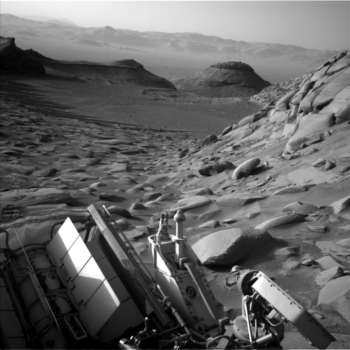
Curiosity’s location as of Sol 3796. Distance Driven to that sol: 18.56 miles/29.87 kilometers.
Credit: NASA/JPL-Caltech/Univ. of Arizona
NASA’s Curiosity Mars rover at Gale Crater is now performing Sol 3797 duties.
Scott VanBommel, a planetary scientist at Washington University, reports that the rover spent much of the last week completing a software upgrade while the science team met virtually to synthesize and discuss results.

Curiosity Front Hazard Avoidance Camera Left B image taken on Sol 3796, April 11, 2023.
Image credit: NASA/JPL-Caltech
“That upgrade has been completed successfully,” VanBommel adds, “and Curiosity was back to work characterizing a local canyon in an effort to study the composition and sedimentology of the geologic units above ‘Tapo Caparo.’”
Regular cadence
While continually on the lookout for its next drill location, VanBommel adds that Curiosity will maintain a regular cadence of chemical and textural analyses of rocks along its canyon-transecting traverse.

Curiosity Left B Navigation Camera image acquired on Sol 3796, April 11, 2023.
Image credit: NASA/JPL-Caltech
Chemical analysis and imaging efforts were central to tosol’s plan which focused on the Alpha Particle X-Ray Spectrometer (APXS) and the Mars Hand Lens Imager (MAHLI) on a brushed rock face, “Tarilandia,” before the rover executed a planned drive of roughly 98 feet (30 meters).

Curiosity Left B Navigation Camera image acquired on Sol 3796, April 11, 2023.
Image credit: NASA/JPL-Caltech
Strikingly round stone
“As APXS prefers colder temperatures and MAHLI benefits from midday illumination, a one-hour science block between these two arm activities rounded out the geologic science planned before the drive,” VanBommel notes.

Curiosity Left B Navigation Camera image acquired on Sol 3796, April 11, 2023.
Image credit: NASA/JPL-Caltech

Curiosity Chemistry & Camera (ChemCam) Remote Micro-Imager (RMI) photo taken on Sol 3796, April 11, 2023.
Image credit: NASA/JPL-Caltech/LANL

Laser hits, taken by Curiosity Chemistry & Camera (ChemCam) Remote Micro-Imager (RMI), acquired on Sol 3796, April 11, 2023.
Image credit: NASA/JPL-Caltech/LANL
The science block included a Mastcam crater rim extinction image and an extension of the “Tutu Kampu” mosaic. Mastcam also documented the targets “Loulouie” and Tarilandia.
Lastly, the robot’s Chemistry and Camera (ChemCam) imaged and conducted laser analyses on the target “Bem Querer,” a strikingly round stone, Towards the end of the drive, Curiosity was to acquire imaging that will support targeting in an upcoming one-sol plan, VanBommel concludes.

